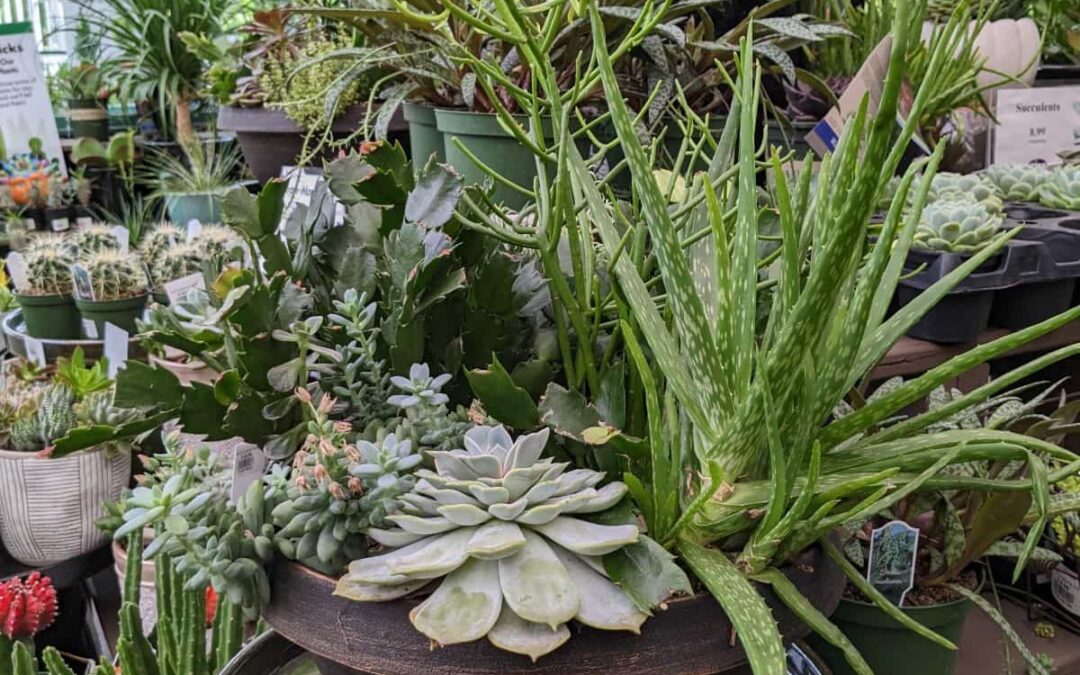
by | | Garden Week In Georgia, Gardening, Plants
How to be an Aloe Vera parent:
• Your child needs bright, but not direct, sunlight.
• To grow big and strong, water once a week if the soil is dry. Do no drown it. Fertilize with water-soluble plant fertilizer once a month. You can use fertilizer spikes available at garden centers—very easy to use with no mess. Read the directions.
• Your child likes it outdoors when there is no danger of frost. April 15, put it outside where it gets light and humidity—no direct sun. Continue to water and fertilize.
• In the summer, your aloe will sprout new plants, and you will be a grandparent. Isn’t that sweet?
• Next fall before November 7, carefully repot your aloe and tenderly remove the grandbabies. Pot the grandbabies and give them to your friends. They will smile.
• Do not allow your friends to say “Thank You” for the plant. They should only say, “I will give this plant a good home.” That’s something my Aunt Juanita taught me.
• Read about your plant on the internet. The aloe has amazing healing qualities. Your child will be handy to have around the house especially to soothe cooking-related burns.
Good Luck to you. If you have any questions, stop by the ABA booth at the Downtown Alpharetta Farmers Market and Ask a Master Gardener. Or call the Master Gardener HOTLINE 404.613.7670 or go online to http://extension.uga.edu/publications.html for tons of helpful gardening information.
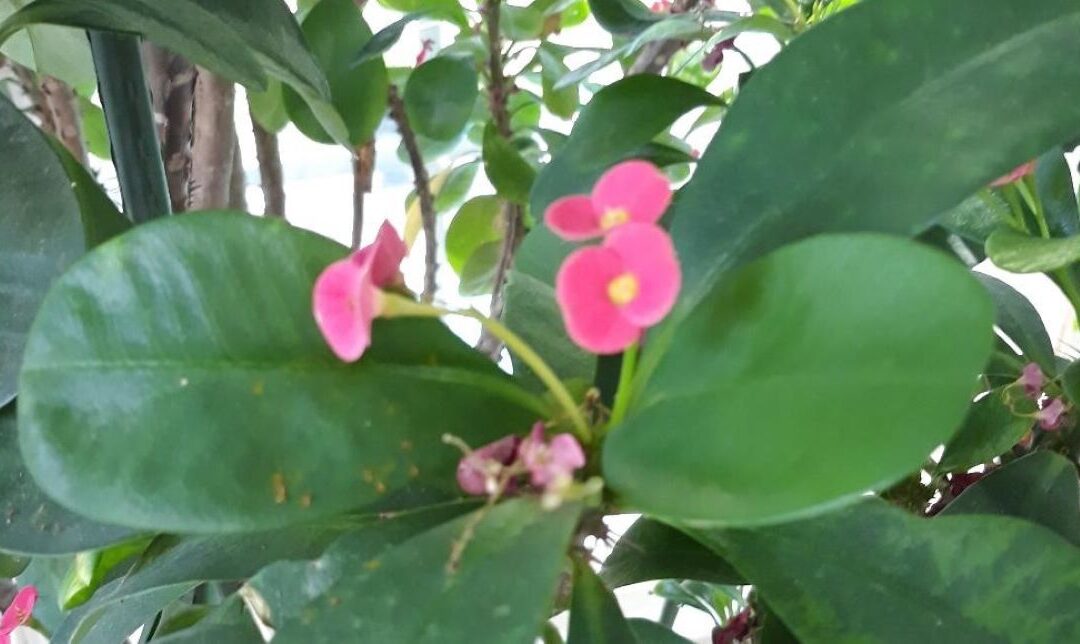
by | | Garden Week In Georgia, Gardening, Plants
My journey with Sonoma Crown of Thorns started as an annual in my butterfly garden about 25 years ago. Of course, being a 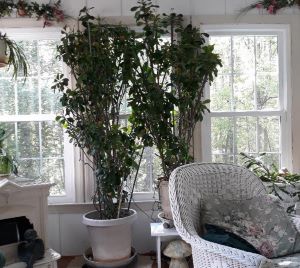 tender annual, they bought the farm at the first frost. The next year, I kept them in pots and knew to bring them in before the temperatures got nasty. They have been my botanical companions ever since. They spend about 6 months outside around the pool and then another 6 months in my sunroom. In winter, they get festooned with white lights because it amuses me. In the summer, they act as a botanical screen in front of my filter and heater by the pool. For the entire year, they never stop blooming. While I’m not a big fan of thorny succulents, these plants have won my heart. Now for the specifics: Crown of thorns, also known as Christ plant or Christ thorn, is a flowering plant native to Madagascar, introduced to France in the early nineteenth century by Baron Pierre Bernard Milius, then-governor of Réunion, a region in the western Indian ocean. The crown of thorns is part of the spurge family, or Euphorbiaceae, which contains many different species of succulent plants. Crown of thorns are low maintenance, easily adaptable, and can thrive as an indoor plant or outdoors (in USDA Hardiness Zones 9–11).
tender annual, they bought the farm at the first frost. The next year, I kept them in pots and knew to bring them in before the temperatures got nasty. They have been my botanical companions ever since. They spend about 6 months outside around the pool and then another 6 months in my sunroom. In winter, they get festooned with white lights because it amuses me. In the summer, they act as a botanical screen in front of my filter and heater by the pool. For the entire year, they never stop blooming. While I’m not a big fan of thorny succulents, these plants have won my heart. Now for the specifics: Crown of thorns, also known as Christ plant or Christ thorn, is a flowering plant native to Madagascar, introduced to France in the early nineteenth century by Baron Pierre Bernard Milius, then-governor of Réunion, a region in the western Indian ocean. The crown of thorns is part of the spurge family, or Euphorbiaceae, which contains many different species of succulent plants. Crown of thorns are low maintenance, easily adaptable, and can thrive as an indoor plant or outdoors (in USDA Hardiness Zones 9–11).
Crown of thorn plants have green leaves and small, colorful flowers. This plant also has sharp, spiny stems and branches that excrete a milky sap when broken. If you are considering a crown of thorns as a houseplant, be advised that they have high toxicity and can be poisonous to animals and humans if ingested.
Crown of thorns are neglect-tolerant and require little maintenance. However, when caring for crown of thorns plants, it’s essential to wear gloves, as the latex sap from this plant can cause eye and skin irritation. To keep your crown of thorns thriving, see the steps below:
1. Keep your environment temperate. Crown of thorns plants grow best indoors at a temperature of 65 to 75 degrees Fahrenheit but can tolerate higher or lower extremes.
2. Provide enough sun. Crown of thorns should get full sun for three to four hours every day. Keep your plants in a sunny window where they can receive enough direct sunlight.
3. Avoid overwatering. Only water your crown of thorns when the top inch of soil has dried, and ensure there isn’t any water collecting near the roots. You can wait until the top three inches of the soil have dried before watering in the winter months.
4. Fertilize. Use a liquid fertilizer every few weeks during fall, spring, and summer. When the plant is more dormant in the winter, you can dilute the fertilizer and use it less often.
5. Monitor for pests or fungal diseases. Crown of thorns plants are susceptible to mealybugs, spider mites, and leaf-spotting diseases. You can avoid plant diseases by limiting watering and prevent the emergence of pests by pruning away old or damaged branches that can provide hiding places for destructive insects.
Yes, it has become a major undertaking to transition my botanical buddies inside and outside every year. We are now using a hand truck and wheeling them in and out through the garage. And now these two survivors have a little sibling. Two years ago I found a white crown of thorns. Like his 20+ year old cousins, he started out in a 4 inch pot, and has now graduated to a 10 inch pot. He sits next to and we hope is inspired by his towering brethren. The fact that they flower all year and require very little care is such a big plus. As of now, they come in pink, white and if you can find it the newest color yellow. Is it any wonder the Atlanta Botanical Garden has them in their desert greenhouse.
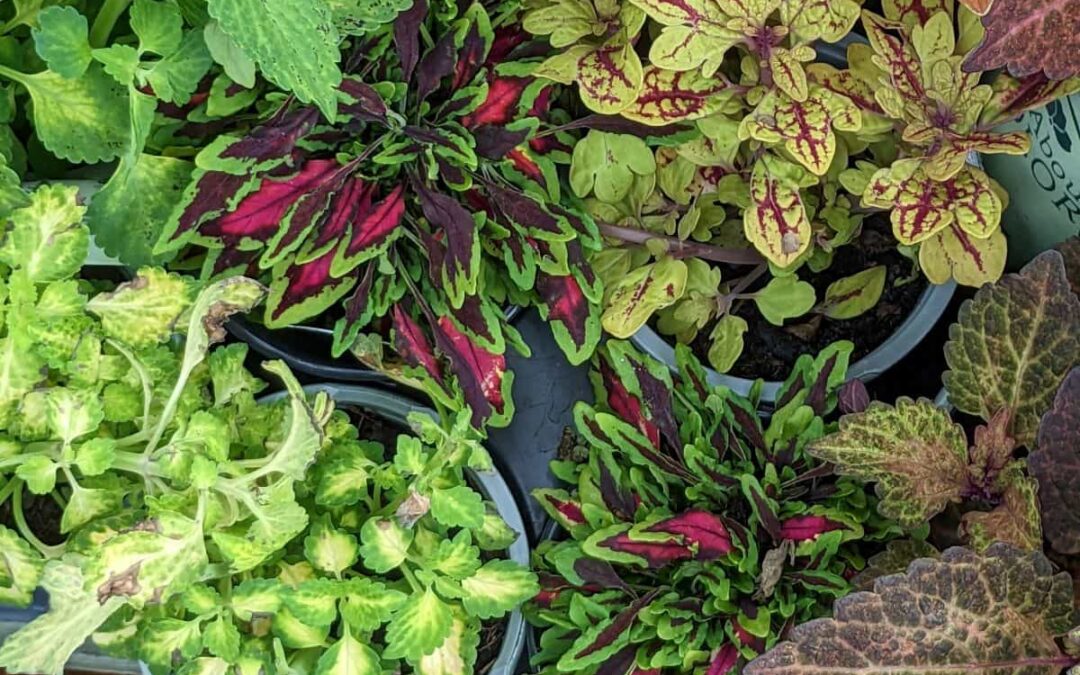
by | | Garden Week In Georgia, Gardening, Plants
During May gardeners work to refine the look of their beds and add containers for accents. In recent years the easy-care coleus, coleus X hybridus, has evolved and deserves attention. There is a vast array of colors, sizes, and leaf shapes available at nurseries. Several new varieties of sun-tolerant coleus are on the market. Besides the striking foliage, many coleus are deeply lobed and have cut margins. Some of the trailing varieties are perfect “spillers” for containers. With all these improvements, coleus deserve the resurgence they are experiencing.
In Zone 7, coleus are annuals that do best with morning sun and afternoon shade. They are not picky about the soil, but good drainage is critical. They perform best if they are watered and fed regularly with a water-soluble fertilizer. Use snippers to remove flower spikes as they appear. This encourages better growth and dense branching. Removing the flowers makes the plant use its energy to produce the dramatic foliage instead of the lackluster flower/seed combination it generates.
Garden magazines feature the adaptable coleus in beds, borders, and containers. One color planted en masse makes a bold statement. Using a foliage color to echo or unify the surrounding plants is a good trick. Planting bright coleus with splashes, blotches, or streaks can really brighten a shady area. Floral designers grow coleus to add color to arrangements. Look online for images of containers and beds that feature coleus. You will be inspired.
Propagating coleus is simple. Take cuttings of your favorite plants and place them in a jar of water. Be sure to clip any submerged leaves. The plants will quickly root and thrive. Change the water if it gets cloudy. The cuttings will easily overwinter in a sunny location indoors. Next spring they will flourish when planted outdoors after April 15.
Be bold this year–add the hardy coleus to your landscape and experiment with propagation. Look for information about these versatile performers at: extension.uga.edu/publications: Landscape Basics: Color Theory Bulletin 1396; Flowering Annuals for Georgia Gardeners Bulletin 954; Gardening in Containers Circular 787.

by | | Garden Week In Georgia, Projects
RGC’s district hosts The Garden Club of Georgia annual convention this year. I’m a co-chairman of the event. My areas of responsibility include door prizes, raffles, ways & means, and registration. RGC members have been busy working behind the scenes to help prepare for the convention. During the convention we will be busy helping with the event and attending activities. I thought you’d like a glimpse of some of the behind the scenes prep work.

Our RGC members and Dogwood District members have been busy sorting donations, creating and assembling 52 baskets, 20 door prizes, silent auction, and ways & means. I am very proud of our members who have come out to volunteer. Also, I’m proud of all our ladies who have signed up for volunteering at Convention.
Basket makers 
Notice the work area of donated items to assemble into baskets and bags

There was plenty of work for everyone who could help

My husband Wade’s aunt of 86 years old painted this original acrylic painting just for the Silent Auction Convention. She is so excited to contribute something to the Convention.
Bags and baskets are ready, tickets are counted, and we are ready to celebrate Garden Week in Georgia at the annual convention!
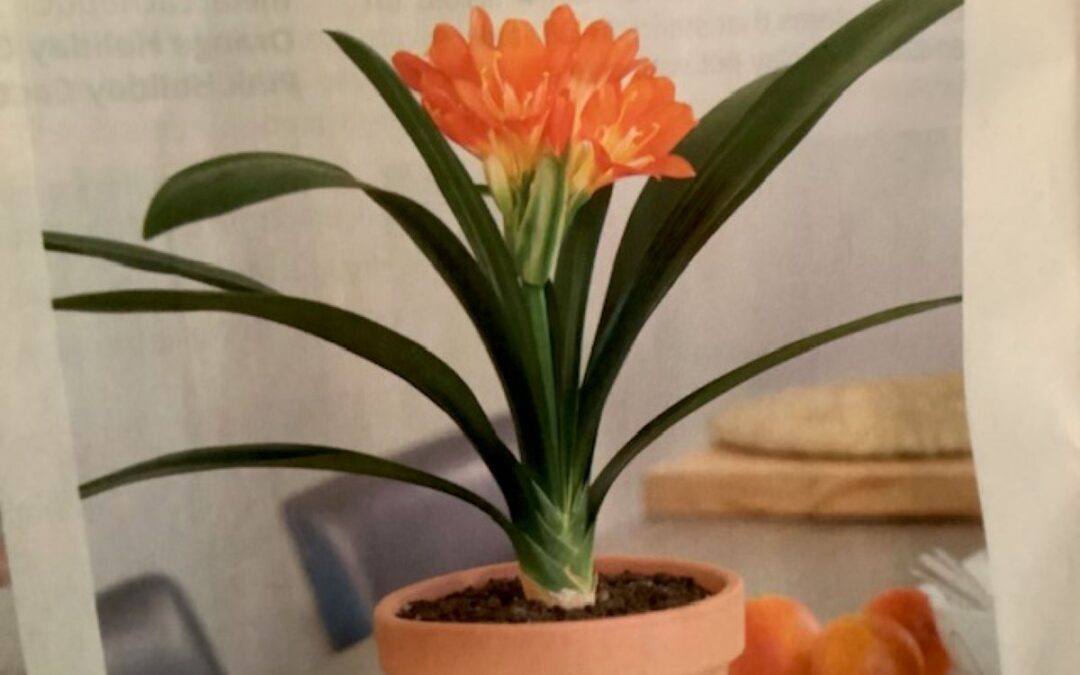
by | | Garden Week In Georgia, Gardening, Plants
I am originally from the Philadelphia area. They have a wonderful zoo and I have fond memories of visiting there when I was young…..but for the reptile house! My sister went to a plant sale there many years ago…probably in the mid 1970’s. She bought a Clivia plant for me, from their collection. So, possibly 45 or so years ago she gave me this plant.
Clivia is attractive with green strap-like leaves and showy orange blooms in the summer. The bloom time can vary depending on location, but mine bloom in mid-summer. My plant spends the winter on my glass porch that maintains a temperature in the mid 60’s. I keep it watered and lightly fertilized. At this time of year I move it outside and put the pot on my porch and then I move it to the garden when it is warmer.
My Clivia reliably blooms in the summer, producing large orange blooms, and can rebloom. Since I spend my summer months in New Hampshire, my neighbors tell me when it is in bloom and often send a photo. Over the years I have divided this and repotted it numerous times…… Possibly every 5 or more years. It grows robustly and needs this repotting or it’s vigorous roots can break the pot.
The blog post photo is a young Clivia. My plant fills its pot. If you try Clivia, you may find you have a lifetime companion plant like mine.

by | | Garden Week In Georgia, Gardening
Garden Week in Georgia starts today, April 16, and runs through April 22. This year’s GWG posts start with some fun ways for you to celebrate the week. Some depend on good weather, others on room at an event, and others on an adventurous spirit. Hope you can make time to celebrate gardens!
- April 16 there’s a free Urban Gardening Workshop from 12 – 2 pm @ 333 Peters Street Southwest Atlanta, GA 30313. This workshop is led by Ayanna Burroughs, a Farm to School advocate and home gardener. Interested? Registration is required. Go to the event site for more details or to register.
- On April 16, head head to the State Botanical Gardens in Athens, for the Decatur Digital Photography Meetup or head up any time during the week and have fun developing your floral photography skills on your own.
- Any day during the week, pick up a beautiful floral puzzle and put it together. The photo for this blog post is a puzzle put together by RGC member Marcia.
- The Garden Clubs of Georgia Annual State Convention is April 19 & 20. Dogwood District, which RGC belongs to, is hosting the event. Registration is required, and is now closed. Many RGC members are helping with the event and lookinf forward to attending it. Read more about the convention in a blog post later this week.
- April 19 check out the Drop-In Kids Gardening Activity @ the Atlanta Botanical Garden from 10 – 11 AM. Read more on Atlanta Botanical Garden | Drop-In Kids Gardening Activity
- Apr 21 & 22 head over to Smith-Gilbert Gardens, 2382 Pine Mountain Rd, Kennesaw, GA for The Seedling: An Immersive Family Experience presented by the KSU Theatre Department & Smith Gilbert-Gardens. Performances at 10 am and 1:30 pm. Read more and get tickets here.
- April 22 take part in the Keep Douglasville Beautiful Spring Planting Day 2 @ Mill Village Community Garden, 6302 Johnson Street, Douglasville, Georgia 30134. Keep Douglasville Beautiful is holding a Spring Planting Day to educate those willing to learn how to plant vegetables and flowers. The group also wants to supply the Mill Village Community with an abundant harvest come summertime! Assist with planting summertime vegetable starters and flowers. Be sure to bring water and gloves.
- April 22 take part in The Joy of Container Gardening Workshop & Carnegie Spring Festival! from 10 – 11 AM @ the Newnan Carnegie Library, 1 Lagrange St, Newnan, GA. Registration is required for the workshop. Go to the event site for more details or to register.
- April 22 & 23 drop by the Alpharetta Garden Club Annual Plant Sale. Join them at the historic Mansell House and Gardens on Old Milton Parkway for their annual plant sale. They will have lots of native plants; most pulled from members’ gardens! Hours are 9am to 3pm on Saturday and 10am to 2pm on Sunday.

by | | Gardening, Horticulture, Plants
A member of the ageratum family, this is a reseeding annual with pompom flowers in blue just like the bedding plants you buy at nurseries, but with a much taller growing habit and grown from seeds. Tall, upright, sturdy stems. Tight blue flower clusters. Use as a classic filler for mixed bouquets or plant to attract bees and butterflies to your garden. Ageratum is also known as flossflower or blue mink. Can grow in the Mediterranean, desert, subtropical, temperate or tropic climate and growing in hardiness zone 3+. Ageratum is deer and rabbit resistant.
How to grow Ageratum Blue planet growing and care: Rich soil, well-drained soil, moist soil
What is the best way to start growing? Plant / Seedling / Seed 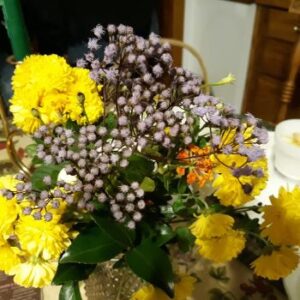
Difficulties or problems when growing: Invasive
When is the best time to plant? Spring
Pests and diseases: Aphids, spider mites
Pruning season: All growing season
How to prune: Dead leaves and flower
Size of the plant: 60-80 cm, 24-32 inches
Growth speed in optimal condition: Fast growing / Medium growing
Water requirement: Average amount of water
Light conditions in optimal condition for growing: Full Sun / Half shade
Is it possible to grow indoor as houseplant? No
Growing is also possible in a planter /flowerpot / containers: Yes
Bloom season? Summer / Autumn

by | | Gardening
Roswell Garden Club and Soil3 have so much in common. We both want to make Roswell and its surrounding cities look more beautiful. We hope you will make your spring soil purchase using the links below. With Soil3, you get the best products for all your planting needs and will save $5 on The Big Yellow Bag. Your purchases of The Big Yellow Bag and the mini cube support RGC goals and projects.
RGC’s fundraiser is for the single Big Yellow Bag (1 cubic yard) of Humus Compost, Veggie Mix or Soil3 Level Mix and the single Grab’n’Go Mini Cube (1 cubic foot) of Humus Compost or Veggie Mix.
Mini-cubes can be picked up from a local Super-Sod Store. The fundraiser does not apply to any other specials offered by Soil3. You may order as many bags as you like of each product. Please make sure our promo code is showing at checkout.
Why Soil3?
- Reduces the need for harsh chemicals
- Provides enough nutrients for season-long growing-no need to apply additional fertilizer
- 4 times the water retention of regular soil
- Approved for Organic Gardening by OMRI, the Organic Materials Review Institute
Click here to shop for Big Yellow Bags RGC’s promo code is Roswell2023
Click here to shop for Mini Cubes RGC’s promo code is Roswellmini23
Please note: Each link must be used separately to order
Thank you for your support.
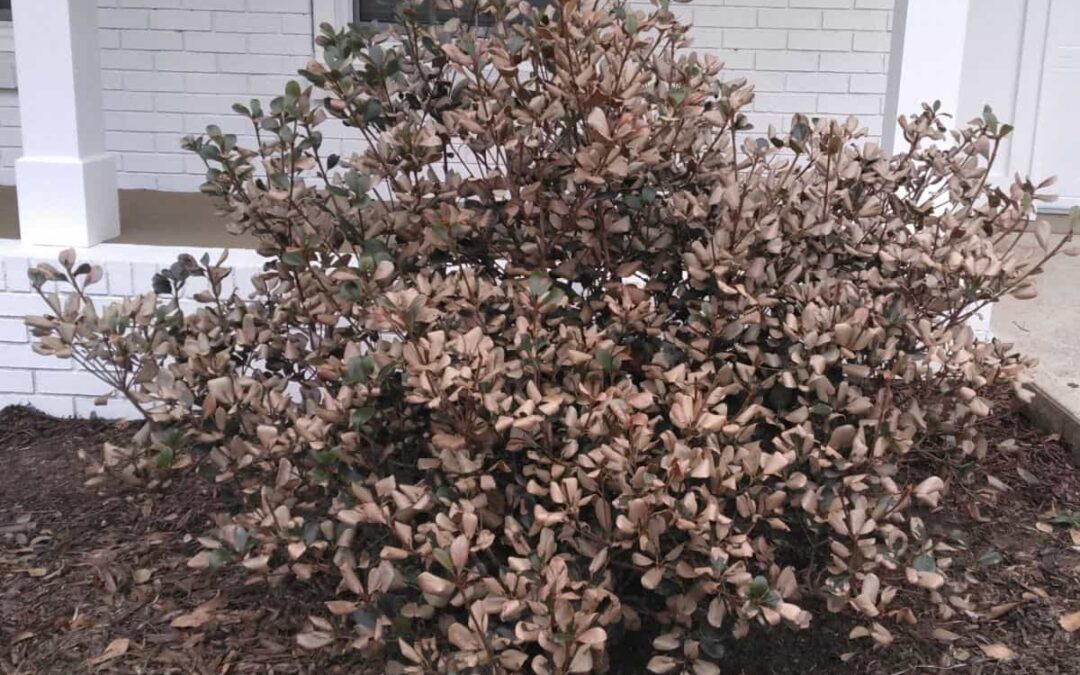
by | | Gardening, Horticulture, Plants
If you’re like me, this winter’s extra-cold temperatures have taken a toll on many of your plants. I’m itching to cut off the freeze damage, but that is not what experts recommend.
In a recent article in the Gwinnett Daily Post, Tim Daly, UGA Extension Ag & Natural Resources Agent, gives several great tips for assessing and dealing with freeze damage. These tips assume your plants are cold hardy and appropriate for zone 7B.
- Bronze colorization doesn’t mean a plant or a branch is dead…it’s the plant’s reaction to a big chill
- Scratch the bark with your fingernail. If the stem tissue is green or white, the wood is still alive…look for new growth in the spring 🙂
- If the stem tissue is brown or brittle, the branch is dead. Remove this wood in the spring, after all threats of a freeze have passed.
- Do NOT fertilize now. This could damage or kill the plant. Wait until all threats of a freeze have passed.
Brandon Voutour, a manager at Liberty Landscape Supply at Trad’s in the San Jose neighborhood of Jacksonville Florida, had a few tips for rehabbing cold-damaged plants on News4JAX:
- Water everything, even if you think it is dead. Water will help keep the plant alive & revive parts you may think are dead.
- Don’t remove dead leaves or other damage until spring. Most perennials and grasses will come back.
So…hold off for now. It’s okay to add mulch and to water, but otherwise be patient.
Here’s hoping we don’t have much freeze-damage!
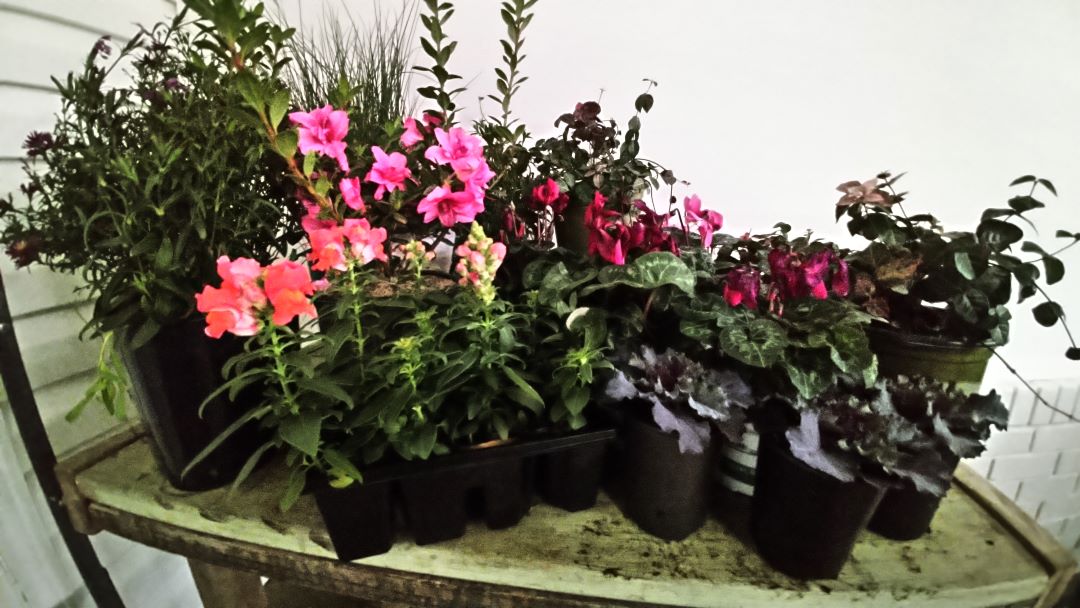
by | | Gardening, Horticulture, Inspiration, Plants
I like to buy plants for my containers that can be planted in the yard at the end of their bloom season. This fall I felt the need for large bursts of color and enticing texture, so I did a little research before heading out and put Brown’s Japanese Yew, Huechera, Floral Berry (St. John’s Wort), Stone Crop, Hens & Chicks, Compact Oregon Grape, and Lime Twist Sedum on my list of plants to look for.
After my first stop, Snow ‘N Summer Asiatic Jasmine, mugo pine, cabbage, and violas were added to the list. I hadn’t bought anything yet, though. At my next stop, Frenzy Juncus, an Autumn Empress Encore Azalea, a few Hazy Dark Pink Asters, and a pack of SnapdDragons jumped the list and hopped into my cart. They called my name, and there weren’t many of them, so I needed to get them right away. Oh, and 5 hot fuscia cyclamen. I love cyclamen. I’d forgotten that there were varieties that are hardy to -25 degrees, so I was thrilled to read the plant tag and see that these gorgeous plants should thrive here in metro Atlanta. Then I remembered a container I’d seen in Gardens Illustrated’s Pots of Style that included cyclamen in winter in England. Those cyclamen were definitely hardy to very low temperatures.
I headed back to stop one and picked up some of the Snow ‘N Summer Asiatic Jasmine (hardy to 0 – 10 degrees); some gorgeous dark purple cabbage (an exception to my replant rule), and a Blue Point Juniper to add to the mix.
My day is brightened by their beauty every time I look out one of my windows. The plants look like they are very happy out there. I hope you get the chance to bring such beauty into your day whether the plants are inside or outside.



 tender annual, they bought the farm at the first frost. The next year, I kept them in pots and knew to bring them in before the temperatures got nasty. They have been my botanical companions ever since. They spend about 6 months outside around the pool and then another 6 months in my sunroom. In winter, they get festooned with white lights because it amuses me. In the summer, they act as a botanical screen in front of my filter and heater by the pool. For the entire year, they never stop blooming. While I’m not a big fan of thorny succulents, these plants have won my heart. Now for the specifics: Crown of thorns, also known as Christ plant or Christ thorn, is a flowering plant native to Madagascar, introduced to France in the early nineteenth century by Baron Pierre Bernard Milius, then-governor of Réunion, a region in the western Indian ocean. The crown of thorns is part of the spurge family, or
tender annual, they bought the farm at the first frost. The next year, I kept them in pots and knew to bring them in before the temperatures got nasty. They have been my botanical companions ever since. They spend about 6 months outside around the pool and then another 6 months in my sunroom. In winter, they get festooned with white lights because it amuses me. In the summer, they act as a botanical screen in front of my filter and heater by the pool. For the entire year, they never stop blooming. While I’m not a big fan of thorny succulents, these plants have won my heart. Now for the specifics: Crown of thorns, also known as Christ plant or Christ thorn, is a flowering plant native to Madagascar, introduced to France in the early nineteenth century by Baron Pierre Bernard Milius, then-governor of Réunion, a region in the western Indian ocean. The crown of thorns is part of the spurge family, or 












